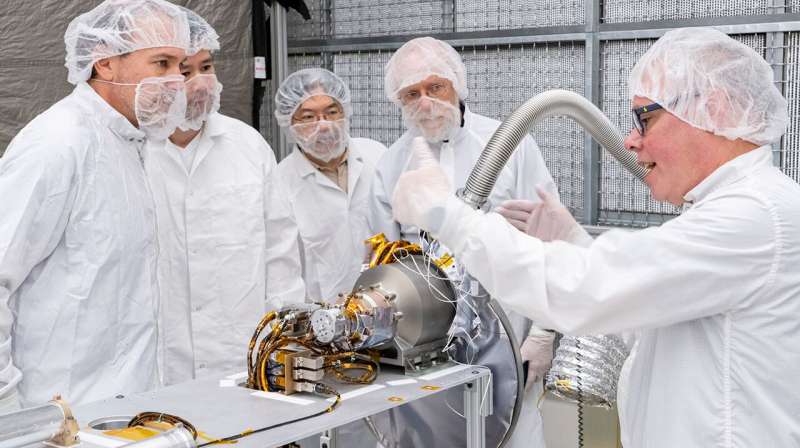This article has been reviewed according to Science X's editorial process and policies. Editors have highlighted the following attributes while ensuring the content's credibility:
fact-checked
trusted source
proofread
NASA delivers science instrument to JAXA's Martian Moons mission

On March 14, NASA handed over its gamma-ray and neutron spectrometer instrument to JAXA (Japan Aerospace Exploration Agency) for integration onto JAXA's MMX (Martian Moons eXploration) mission spacecraft and final system-level testing.
NASA's Mars-moon Exploration with Gamma Ray and Neutrons (MEGANE) instrument, developed by the Johns Hopkins Applied Physics Laboratory (APL) in Laurel, Maryland, in collaboration with colleagues from Lawrence Livermore National Laboratory (LLNL) in California, will play a major role in the MMX mission, which aims to characterize and determine the origin of Mars' moons Phobos and Deimos and deliver a sample from Phobos to Earth.
Scientists suspect the asteroid-sized bodies either are remnants of an ancient collision between Mars and a large impactor or are themselves asteroids captured by Mars' gravity. By measuring the energies of neutrons and gamma rays emitted from the surface of Phobos, MEGANE will let MMX "see" the elemental composition of the moon's surface and help peg the likely origin of the moon.
"MEGANE will be a key instrument on MMX, making a big contribution toward the goal of understanding the origin of the Martian moons," said Thomas Statler, MEGANE program scientist at NASA Headquarters in Washington. "NASA is glad to see MEGANE ready for integration, another step in NASA's continuing collaboration with JAXA on this groundbreaking mission."
The instrument team received the green light last fall to ship MEGANE (pronounced meh-GAH-nay, the Japanese word for "eyeglasses") after the project's standing review board evaluated the device's readiness. That milestone marked the end of a demanding 6-year design and development process, which met NASA's cost and schedule constraints.
"Passing the pre-ship review and delivering the hardware are significant steps for all those working on MEGANE," said APL's David Lawrence, the instrument's principal investigator. "Like all spaceflight builds, we have had challenges getting to this point, but we are excited to see how MEGANE works with all the other spacecraft components for this exciting MMX mission."
APL staff members Erin Hoffer and John Stinchcomb were in Japan to participate in the handover of the MEGANE hardware to JAXA and the spacecraft manufacturer Mitsubishi Electric Corporation (MELCO) on Wednesday.
MEGANE is the latest in APL's growing list of neutron and gamma-ray spectrometer instruments developed for space missions, which include NASA's MESSENGER mission to Mercury, the Psyche mission launched in October 2023 and the agency's upcoming Dragonfly mission.
With MEGANE now in Japan, the MMX team will begin integrating the scientific instruments, including MEGANE, with other spacecraft components, before putting the entire system through a series of tests in preparation for launch, which is scheduled for fiscal year 2026, aboard a JAXA H3 rocket.
"For me personally, I'm looking forward to all the integration and test operations that are to come," said Sarah Bucior, a space systems engineer at APL and the MEGANE I&T Lead Engineer. "I love rockets, so I'm really interested to see how they build their spacecraft and then follow it along to launch operations and liftoff."
Provided by Johns Hopkins University





















